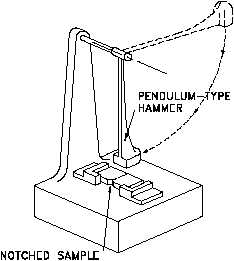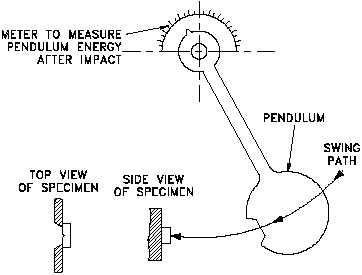PHYSICAL PROPERTIES
DOE-HDBK-1017/1-93
Properties of Metal
Therefore, the criterion of fracture (that is, the limit of plastic deformation) for a plastic material
is likely to depend on tensile rather than compressive stress. Temperature change may modify
both the plastic flow mode and the fracture mode.
Figure 8 Charpy Test Equipment
The quality known as toughness describes the way a
material reacts under sudden impacts. It is defined as
the work required to deform one cubic inch of metal
until it fractures. Toughness is measured by the
Charpy test or the Izod test.
Both of these tests use a notched sample.
The
location and shape of the notch are standard. The
points of support of the sample, as well as the impact
of the hammer, must bear a constant relationship to
the location of the notch.
The tests are conducted by mounting the samples as
shown in Figure 8 and allowing a pendulum of a
known weight to fall from a set height.
The
maximum energy developed by the hammer is 120 ft-lb in the Izod test and 240 ft-lb in the
Charpy test. By properly calibrating the machine, the energy absorbed by the specimen may be
measured from the upward swing of the pendulum after it has fractured the material specimen
as shown in Figure 9. The greater the amount of energy absorbed by the specimen, the smaller
the upward swing of the pendulum will be and the tougher the material is.
Figure 9 Material Toughness Test
Indication of toughness is relative
and applicable only to cases
involving exactly this type of
sample and method of loading. A
sample of a different shape will
yield an entirely different result.
Notches confine the deformation to
a small volume of metal that
reduces toughness. In effect, it is
the shape of the metal in addition
to the material composition that
determines the toughness of the
material.
MS-02
Page 26
Rev. 0



